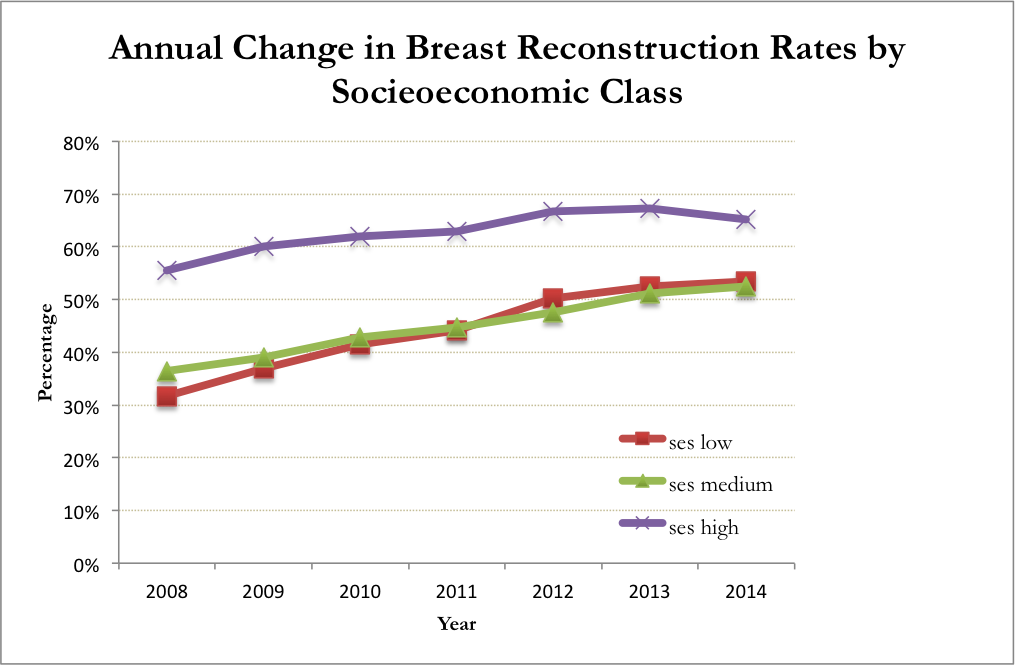The Impact of the 2010 NY State Breast Cancer Provider Discussion Law on Breast Reconstruction Rates: An Analysis of 42,137 Patients From the NY SPARCS Database
Rose Fu, MD, Onur Baser, MS, Jessica Means, BA, Paul Kurlansky, MD, FACS, Christine Rohde, MD, MPH, FACS.
Columbia University Medical Center, New York, NY, USA.
Background
The percentage of women seeking breast reconstruction remains low despite rising mastectomy rates and federal laws mandating insurance coverage. The New York State (NYS) Breast Cancer Provider Discussion Law, effective January 2011, mandates provider discussion of breast reconstruction in order to improve patient awareness of post-mastectomy reconstructive options. This study examines the law's impact on reconstruction rates.
Methods
We used the NYS Planning and Research Cooperative System (SPARCS) database and the US Census Bureau American Community Survey to examine breast reconstruction rates three years before (2008-2010) and four years after (2011-2014) law enactment, stratifying by socieoeconomic status (SES), median income bracket (MIB), age, insurance type, and race.
Results
We examined 42,137 patients. There was a decline in the absolute volume of mastectomies from 6479 in 2008 to 4488 in 2014, with an increase in percentage of women seeking reconstruction from 49% in 2008 to 60% in 2014. These reconstruction rates in NYS overall were significantly higher than the national average of 32.3% (p<0.01). This rise was seen across all SES, MIB, races, age groups, and insurance types. A significantly higher percentage of Caucasians chose reconstruction when compared to other races for any given year (p<0.01). African Americans (AA) experienced the biggest change in breast reconstruction rate, from 41% of AAs seeking reconstruction before law passage to 51% after law passage, and increase of 25% (p<0.01). This was followed closely by Asians (18% increase, p<0.01) and Caucasians (12% increase, p<0.01). High SES and MIB were associated with higher rates of breast reconstruction. Patients with low SES however, experienced the greatest change in breast reconstruction rates, increasing 35%, from 37% pre- to 50% post-law enactment of patients choosing breast reconstruction (p<0.01). Medium and high SES also had lower but still significant increases of 24% and 11% respectively (p<0.01, Figure). This finding was paralleled in the analysis of MIB, where the highest increase occurred in those with the lowest MIB ($0-$36,580) experiencing a 30% surge in rate of breast reconstruction (p<0.01). Those with lower MIB ($36-580-$49,567), higher MIB ($49,567-$65-885), and highest MIB ($65,885-$200,000) had increases of 15%, 13% and 9% respectively in breast reconstruction rates after law passage.
Conclusions
The aim of the Breast Cancer Provider Discussion Law is to improve breast reconstructive rates through provider-driven patient education. Our data shows a significant change in reconstructive rates following law passage. This change, seen most acutely in minority populations, those with lower MIB, and low SES suggests effectiveness of the law in improving awareness of both the reconstructive options and the federal mandate for insurance coverage. Further examination of public and provider awareness of this law may further clarify its role on this observed trend in breast reconstruction. The NYS Provider Discussion Law may potentially provide a template for other states to model legislation geared towards patient-centered improvement of health outcomes. 
Back to 2017 Program




